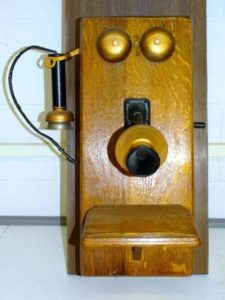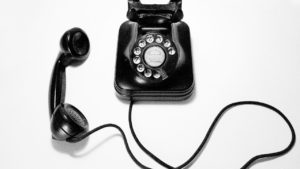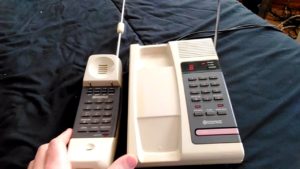
This last week, your humble webmaster purchased a piece of cutting-edge technology, a rare occasion for the hardware Luddite. I scored a Samsung Epic computer/phone which is approximately three times as smart as I am.
In mulling over subjects for today’s piece, I couldn’t get that amazing gadget out of my mind. Ergo, I decided that covering the evolution of the telephone would be an appropriate subject for nostalgic waxing.
Most of us grew up with a sound that’s practically extinct in the 21st century: the ringing of a bell every time a call came in. Almost without exception, we all had basic, durable telephones that were manufactured by the Western Electric Corporation. That particular entity came into being in 1882, just in time to forge a relationship with Alexander Graham Bell that would last 100 years. Western Electric was given the exclusive right to manufacture consumer telephones that would attach to The Bell System. Any other phones would be subject to immediate disconnection.
To their credit, they were much more friendly monopolists than, say, Microsoft. They manufactured a rock-solid, if not especially pretty, product that had a lifespan measured in decades.
Microsoft, of course, makes a pretty product that is as reliable as a car made from macaroni. 😉
But all of that officially came to a halt in 1984, when Bell broke up, and Western Electric lost its exclusive right to make Bell-approved phones. I actually remember purchasing a cheap flip phone in 1983, so Western lost its grip sometime prior to that.
One of the first quantum leaps in telephone evolution was the introduction of push buttons as a replacement for the rotary dial. As I mentioned in the linked article, the 1963 innovation took about ten years to show up as an option in little Bentonville, Arkansas. It was great for wired Type A’s like myself, you could punch in a number in 1/3 the time it took for that slow dial to return to rest. Plus, you got to talk to lots of nice strangers as you mis-punched the numbers.

Telephones first being available in a color besides black was an innovation that many of us recall, circa the early 50’s. Another 50’s innovation was the Princess phone (1959). I remember my best friend in Miami, Oklahoma had an older sister who had one. I was intrigued by its dainty pink appearance for short periods of time, before I was angrily chased out of her bedroom by its owner.
The Trimline phone was introduced in 1965. It allowed an amazing trick: you could make multiple calls without touching the receiver. The hang-up switch was contained in the headset.
By the end of the 60’s, party lines were fast growing extinct. Once a staple even in the big cities, by 1969 they were mostly a rural phenomenon. We lived on a farm in the late 70’s, and I remember what a big deal it was when we finally had a dedicated phone line, about 1976. No more listening for conversation before dialing! No more being asked what your phone number was by by an operator before being connected on a direct-dialed call!
Speaking of that, our kids and grandkids, who now call anywhere in the world for free on Skype or on generous phone plans offered through cable companies, would be amazed if they had to make a call 60’s style to a grandparent two states away. You began by dialing O, then told the operator what type of call you were willing to shell out for: station-to-station, which meant the billing began when the destination phone was answered, or person-to-person, which was pricier, but ensured that you wouldn’t be charged unless a specific person was available at the other end.
Direct dialing began in the big east coast cities in 1951. By the early 70’s, it was pretty much universally available, and AT&T was running lots of 1+ commercials on TV to educate us in how to save money by connecting ourselves to long distance parties.

The next big innovation in telephone evolution was the elimination of the cord altogether. In 1980, the FCC assigned a radio band for the purpose of cordless phone usage. The problem was that it was crap. The band was was very noisy. Thus the earliest cordless phones, besides being huge and expensive, were also nearly unusable. Oh, they were allowed to operate with lots of power, which made making long distance calls on your neighbor’s dime a real possibility.
In 1986, the band was changed and the power was limited, making quieter calls possible, albeit at a shorter range. Prices were dropping for the units, too. By the 90’s, many or most of us Boomers were making cordless calls on the new 900MHz range, which was whisper-quiet and stretched farther than the 1986 band.
It was during that final decade of the 20th century that many of us took the cellular plunge. It began with car phones, contained in a brown bag. Car phones were expensive to buy, and expensive to use. But their coolness factor was unassailable.
By the time the century turned, many of us carried cell phones on our belts or in our purses. It was a real paradigm shift, as we were now available 24/7, for better or worse.
That leads us to today’s smart phones. The iPhone led the way, with Android phones running about six months behind. We are now used to carrying a device which allows instant access to banking, shopping, entertainment, our regular jobs, live-video conversations with people half a world away, and I’m not sure what else. I’m still in the process of learning what all mine does.
Our grandparents saw the first cars, the first airplanes, and the first space shots, perhaps even living long enough to see man walk on the moon. Our own lives haven’t been quite so history-encompassing, but you know what? I still think being a Boomer is the best possible generation in which to live one’s life.